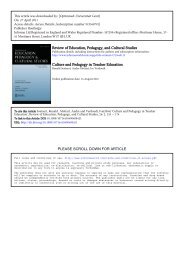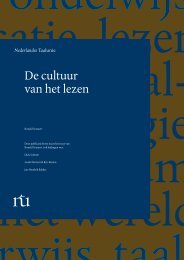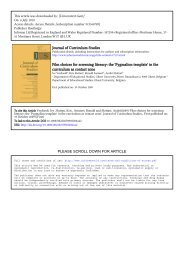a view informed by the problems of traditional literacy in a digital age
a view informed by the problems of traditional literacy in a digital age
a view informed by the problems of traditional literacy in a digital age
Create successful ePaper yourself
Turn your PDF publications into a flip-book with our unique Google optimized e-Paper software.
Downloaded <strong>by</strong> [University <strong>of</strong> Gent] at 06:46 09 December 2011<br />
Ronald Soetaert & Bart Bonamie<br />
developers <strong>of</strong> hypermedia – consciously or unconsciously – jo<strong>in</strong> modern<br />
educational <strong>in</strong>sights that seek to draw attention to <strong>the</strong> process <strong>of</strong> learn<strong>in</strong>g<br />
ra<strong>the</strong>r than <strong>the</strong> mere transfer <strong>of</strong> products. Technological <strong>in</strong>novation<br />
<strong>in</strong>troduces <strong>the</strong> computer as a support<strong>in</strong>g processor.<br />
For quite a while, literary <strong>the</strong>ory and philosophy seem to have been<br />
mentally pav<strong>in</strong>g <strong>the</strong> way for technology. Hypermedia can be read as a literal<br />
application <strong>of</strong> recent postmodern philosophical ideas (Delany & Landow,<br />
1991; Landow, 1992; Lanham, 1993).<br />
With<strong>in</strong> literature itself, <strong>the</strong>re are several texts that, <strong>by</strong> paradoxical<br />
experimentation, try to step outside <strong>the</strong> book. Inevitably, one th<strong>in</strong>ks <strong>of</strong><br />
Sterne’s Tristram Shandy and Joyce’s Ulysses and F<strong>in</strong>negan’s Wake. But<br />
(post)modern literary history is full <strong>of</strong> examples: Cortázar (who <strong>in</strong>vites<br />
readers to start anywhere <strong>in</strong> his novel), Queneau (who wrote a sort <strong>of</strong> sonnet<br />
mach<strong>in</strong>e), Burroughs (with his ‘cut up’ technique), Borges (<strong>the</strong> story as ‘a<br />
network <strong>of</strong> possibilities’), Calv<strong>in</strong>o (his ambition for writ<strong>in</strong>g a ‘hypernovel’ or<br />
his description <strong>of</strong> <strong>the</strong> modern novel as ‘a big network’). Today, a lot <strong>of</strong><br />
literature is be<strong>in</strong>g described as hypertexts avant la lettre and postmodern<br />
literature has been characterised as a node <strong>in</strong> a multidimensional network.<br />
Anthologies<br />
One <strong>of</strong> <strong>the</strong> most important <strong>problems</strong> <strong>in</strong> <strong>the</strong> teach<strong>in</strong>g <strong>of</strong> literature today can<br />
be brought <strong>in</strong>to focus <strong>by</strong> po<strong>in</strong>t<strong>in</strong>g to <strong>the</strong> fact that teachers and pupils sitt<strong>in</strong>g<br />
toge<strong>the</strong>r <strong>in</strong> <strong>the</strong> same classroom participate <strong>in</strong> separate cultural and social<br />
networks. Each k<strong>in</strong>d <strong>of</strong> <strong>literacy</strong> tends to be locked up <strong>in</strong> such a web. The<br />
question for modern teach<strong>in</strong>g is: how can we l<strong>in</strong>k <strong>the</strong>se networks? And<br />
which l<strong>in</strong>ks count as ‘<strong>literacy</strong>’?<br />
In an educational research project conducted from 1993 to 1996 at <strong>the</strong><br />
University <strong>of</strong> Ghent, we approached this problem start<strong>in</strong>g with canonical<br />
European texts like Defoe’s Rob<strong>in</strong>son Crusoe and Cervantes’s Don Quixote.<br />
Many readers were <strong>in</strong>itiated <strong>in</strong>to literary culture <strong>by</strong> <strong>the</strong>se classical stories<br />
(<strong>of</strong>ten <strong>in</strong> adapted forms: children’s versions, film versions or cartoons). They<br />
are stories that, <strong>in</strong> addition, stand at <strong>the</strong> beg<strong>in</strong>n<strong>in</strong>g <strong>of</strong> our novelistic<br />
tradition, and that are used with<strong>in</strong> Western culture to communicate<br />
someth<strong>in</strong>g about that culture (Cervantes, Defoe, Shakespeare, and <strong>the</strong> Bible<br />
are likely to be <strong>the</strong> four most <strong>of</strong>ten quoted names). Hypertext and<br />
hypermedia allowed us to create networks <strong>in</strong> which users can browse and <strong>in</strong><br />
do<strong>in</strong>g so, <strong>the</strong>y learn to deal with <strong>in</strong>formation from various perspectives (an<br />
<strong>in</strong>terdiscipl<strong>in</strong>ary approach); <strong>the</strong>y learn to see <strong>the</strong> canon as a historical<br />
construction; and <strong>the</strong>y acquire an <strong>in</strong>sight <strong>in</strong>to <strong>the</strong> dynamic character <strong>of</strong><br />
literature <strong>by</strong> observ<strong>in</strong>g all <strong>the</strong> possible corrections and adaptations. The<br />
project web site is at: http://dewey.rug.ac.be/NewFriday/<br />
FridayNewHome.html<br />
Compos<strong>in</strong>g a similar collection <strong>of</strong> texts and im<strong>age</strong>s <strong>in</strong> <strong>the</strong> form <strong>of</strong> a<br />
pr<strong>in</strong>ted anthology would be an impossible venture, because <strong>of</strong> <strong>the</strong> bulk and<br />
136





